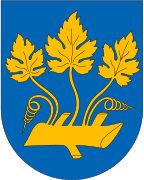Madla
Madla is a borough of the city of Stavanger in Rogaland county, Norway. It lies in the western part of the city, along the coast of the Hafrsfjorden. The 13.87-square-kilometre (3,430-acre) borough has a population (2017) of 21,130.[3] This gives the borough a population density of 1,531 inhabitants per square kilometre (3,970/sq mi).[2] The borough was added to the city of Stavanger in 1965 when the old municipality of Madla was merged into the city.[4]
Bydel Madla | |
|---|---|
 Coat of arms | |
 Location within Stavanger municipality | |
| Coordinates: 58°57′N 05°39′E | |
| Country | Norway |
| Region | Western Norway |
| County | Rogaland |
| District | Jæren |
| City | Stavanger |
| Area | |
| • Total | 13.87 km2 (5.36 sq mi) |
| Elevation | 12 m (39 ft) |
| Population (2016)[2] | |
| • Total | 21,234 |
| • Density | 1,500/km2 (4,000/sq mi) |
| Time zone | UTC+01:00 (CET) |
| • Summer (DST) | UTC+02:00 (CEST) |
| Post Code | 4045 Hafrsfjord |
The borough of Madla have several historical landmarks. During the Viking Age (790-1066 AD), the Battle of Hafrsfjord was fought in the fjord of Hafrsfjord around the year of 872. The violent conflict became one of the most significant battles in the history of Norway as Harald Fairhair was declared the first king of Norway as a result of the conflict.[5]
There are three churches in the borough: Revheim Church, Madlamark Church, and Sunde Church.
Neighbourhoods
Although the borders of "neighbourhoods" (delområder) do not correspond exactly to the borough borders, Madla roughly consists of the following neighbourhoods: Madlamark, Hafrsfjord, Kvernevik, and Sunde.
Politics
Madla borough is led by a borough council (bydelsutvalg). The council consists of 11 members, with the following party allegiances:[6]
| Party Name (in Norwegian) | Number of representatives | |
|---|---|---|
| Labour Party (Arbeiderpartiet) | 2 | |
| Progress Party (Fremskrittspartiet) | 1 | |
| Conservative Party (Høyre) | 2 | |
| Christian Democratic Party (Kristelig Folkeparti) | 1 | |
| Pensioners' Party (Pensjonistpartiet) | 1 | |
| Centre Party (Senterpartiet) | 1 | |
| Socialist Left Party (Sosialistisk Venstreparti) | 1 | |
| Liberal Party (Venstre) | 1 | |
| Local List(s) (Lokale lister) | 1 | |
| Total number of members: | 11 | |
References
- "Madla, Stavanger (Rogaland)" (in Norwegian). yr.no. Retrieved 2016-04-25.
- "Stavanger statistiker - bydeler" (in Norwegian). Stavanger kommune. 1 January 2016. Retrieved 2016-04-13.
- Stavanger Kommune. (2018). Fakta om Madla bydel. Retrieved from https://www.stavanger.kommune.no/om-stavanger-kommune/bydeler-i-stavanger/madla-bydel/fakta-om-madla-bydel/
- Jukvam, Dag (1999). "Historisk oversikt over endringer i kommune- og fylkesinndelingen" (PDF) (in Norwegian). Statistisk sentralbyrå.
- Stavanger Kommune. (2018). Fakta om Madla bydel. Retrieved from https://www.stavanger.kommune.no/om-stavanger-kommune/bydeler-i-stavanger/madla-bydel/fakta-om-madla-bydel/
- "Madla bydelsutvalg" (in Norwegian). Stavanger kommune. Retrieved 2016-04-25.